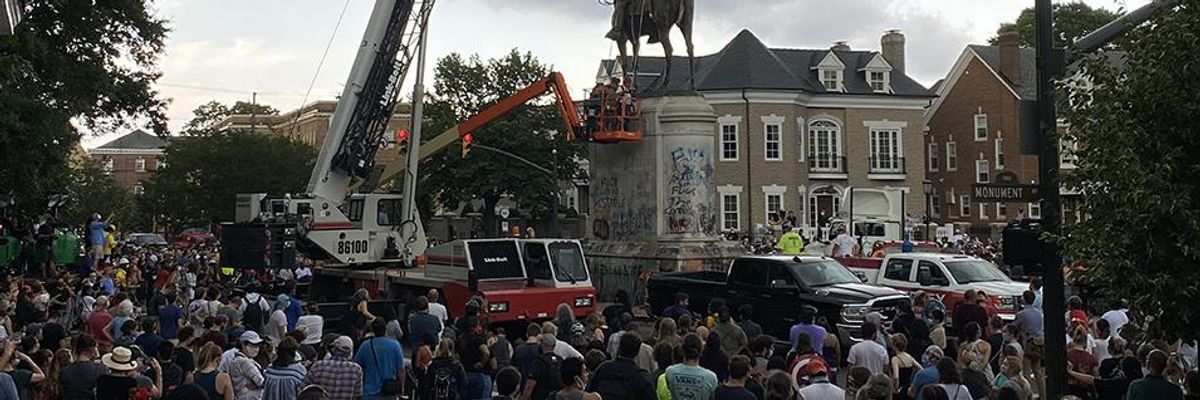"In the winter of '65, we were hungry, just barely alive/ By May the 10th, Richmond had fell/ It's a time I remember, oh so well."
-- from "The Night They Drove Old Dixie Down"
Fifty-one years ago, Robbie Robertson, a Canadian of Jewish and Six Nations descent, wrote the lyrics that the late, great Levon Helm, his musical collaborator in The Band, would make instantly iconic on their eponymous second album.
Perhaps it took someone like Levon -- a hard-drumming son of Arkansas and the only American in a band of wild, singing Canadians -- to convey the melancholy of the southerner trying to reconcile the glory of a manufactured past with the reality of ignominious loss.
But in 1969, when American radio played that song for the first time, there were already intimations that the loss wasn't as definitive as one might have hoped, despite Levon's insistence on stage that "it's a time I remember, oh so well."
After all, there were hundreds of Confederate monuments dotting the South that were allowed to mock the outcome of a Civil War that had ended a century earlier.
Most of those monuments were erected during the Jim Crow era and were intended as rebukes to the democratic aspirations of Black people in the North and the South.
The last Confederate soldier may have died decades before Levon sang , but nostalgia for the Lost Cause continued to stir false memories of a noble history that never was. At best, most of it was antebellum fan fiction elevated to the status of regional religion by white men still haunted by Robert E. Lee's surrender.
"Like my father before me/ I will work the land/ And like my brother above me/ who took the Rebel stand/ He was just 18, proud and brave/ But a Yankee laid him in his grave/ I swear by the mud below my feet/ You can't raise a Cain back up when he's in defeat."
Honestly, you don't have to be a Pulitzer Prize-winning historian or a psychiatrist to realize that the embrace of failed generals and the Confederate flag in the last century was never meant to be about "remembering history."
They were crude attempts to reconcile the contradictions of Southern mythology and diminished regional identity. It reached peak absurdity when the U.S. military branded its most important bases in the South with the names of Confederate traitors, lifting Southern esteem at the expense of a coherent national history.
These monuments were proof that even traitors could undergo the fires of historical redemption without uttering a word of repentance. The monuments weren't placed on pedestals or battle flags flown on the grounds of state capitals to help America remember. On the contrary: They were placed in public spaces to help America forget.
How many times does the Confederacy have to fall before everyone agrees it was a lost cause? How many times must Lee go down to defeat before the bugle sounds? Where are the statues of the abolitionists? Where are the tributes to the Black Union soldiers who helped turn the tide of war? Why can't we find honest accounts of slavery chiseled in stone instead of banished to unread chapters of high school history books?
Why did it take the murder of a Black man by cops in Minneapolis last month to generate the political will necessary for Mississippians to strip the symbol of the Confederacy from its state flag? What kind of perverse relationship to history caused so many Mississippians to hold on to such a hateful symbol for so long?
What kind of "history" did these monuments teach America? What did the people who lived under a disgraced Confederate battle flag learn about humanity from that traitorous piece of cloth? After the governor of Mississippi signed a document "retiring" that hated symbol this week, one has to ask: Why was it so difficult to jettison such an obvious symbol of hate? Why did it take so long?
Unless history is imagined as a one-sided glorification of violence and a cruel social order, the statues were never anything more than mute witnesses to a corrupt status quo. They didn't interrogate anything or anyone, ever. Their very presence shouted "white power" from an era America had already written too many romance stories about.
"Back with my wife in Tennessee/ When one day she called to me/ "Virgil, quick, come see/ There goes the Robert E. Lee"/ Now I don't mind choppin' wood/ And I don't care if the money's no good/ You take what you need and you leave the rest/ But they should never have taken the very best."
This week, Richmond, Va., began removing Confederate statues that had dominated Monument Avenue for most of the 20th century and the beginning of the 21st.
Coincidentally, the removal of Gen. Stonewall Jackson's monument happened just as a thunderstorm descended on Richmond, adding an apocalyptic element to the cheers of hundreds of protesters of all racial persuasions who had gathered to witness its removal.
"The night they drove old Dixie down/ And the bells were ringing/ The night they drove old Dixie down/ And the people were singing/ They went: "Na, la, la, la, na, na/ La, la, na, la, la, la."
